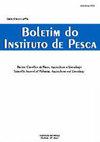不同体重等级的养鱼场捕捞的食人鱼(Arapaima gigas)腰部的近似物成分、能量值和脂质质量
IF 0.6
4区 农林科学
Q4 FISHERIES
引用次数: 0
摘要
该研究旨在确定不同重量级的比拉鲁鱼(Arapaima gigas)腰肉中的脂肪酸概况、欧米茄和脂质质量。共使用了六份皮拉鲁鱼腰肉样本,并按重量等级送至实验室,分别为 1(小于 8 千克)、2(8.1 至 11 千克)、3(11.1 至 14 千克)、4(14.1 至 18 千克)、5(18.1 至 23 千克)、6(23.1 至 32 千克)和 7(大于 32 千克)。实验设计完全随机,一式三份。对数据进行方差分析(ANOVA),以评估不同重量等级的皮拉鲁库里脊肉的差异。当方差分析具有统计学意义(α = 0.05)时,使用 Tukey 检验比较平均值。重量等级 7 的矿物质 = 1.43、粗蛋白 = 28.93 和能量 = 526.35 KJ∙100g-1 值较高。然而,重量 2 级的总脂含量(2.60)和水分含量(78.19)较高。在 pirarucu 里脊肉中发现了必需脂肪酸、EPA、DHA、AA 和 ALA,而重量等级 4 和 5 中的 PUFA 百分比最高。不过,所有重量级别的鱼都含有较高的欧米伽 3、6、7 和 9。没有必要在市场上销售较重的鱼,因为重量较轻的 3 级和 4 级 pirarucu 里脊肉已经满足了市场的营养需求。本文章由计算机程序翻译,如有差异,请以英文原文为准。
Proximate composition, energy value, and lipid quality in loin in different weight classes of pirarucu (Arapaima gigas) from fish farming
The study aimed to determine the fatty acids profile, omegas, and lipid quality in loin in different weight classes of pirarucu (Arapaima gigas). A total of six pirarucu loin samples were used and sent to the laboratory by weight class, 1 (< 8 kg), 2 (8.1 to 11 kg), 3 (11.1 to 14 kg), 4 (14.1 to 18 kg), 5 (18.1 to 23 kg), 6 (23.1 to 32 kg), and 7 (> 32 kg). The experimental design was completely randomized, with processing conducted out in triplicate. Data were submitted to analysis of variance (ANOVA) to assess differences in pirarucu loin between weight classes. When ANOVA was statistically significant (α = 0.05), the averages were compared using Tukey’s test. Weight class 7 showed higher values of mineral matter = 1.43, crude protein = 28.93, and energy = 526.35 KJ∙100g-1. However, weight class 2 showed a higher value of total lipids, 2.60, and moisture, 78.19. The pirarucu loin showed essential fatty acids, EPA, DHA, AA, and ALA, while weight classes 4 and 5 had the highest percentages of PUFAs. However, all weight classes expressed high values in omegas 3, 6, 7, and 9. There is no need to market heavier fish, as pirarucu loin in lighter weight classes 3 and 4 already meet the nutritional demand of the market.
求助全文
通过发布文献求助,成功后即可免费获取论文全文。
去求助
来源期刊

Boletim do Instituto de Pesca
FISHERIES-ZOOLOGY
CiteScore
0.80
自引率
0.00%
发文量
24
审稿时长
>12 weeks
期刊介绍:
To publish original articles of research and short communications in the following áreas: Fisheries, Aquaculture, Zootechnology, Limnology, Oceanography, Biology and Pathology of aquatic organisms. The publication depends on the approval of the Editorial Board, based on the peer review.
 求助内容:
求助内容: 应助结果提醒方式:
应助结果提醒方式:


